Lesson Plan #1
Standards:
- RL.4.3 Describe in depth a character, setting, or event in a story or drama, drawing on specific details in the text (e.g., a character’s thoughts, words, or actions).
- RL.4.6 Explain the differences in the point(s) of view in a text and different perspectives of the characters.
- H.4.3 Sectional issues divided the United States after the War of 1812. Ohio played a key role in these issues, particularly with the antislavery movement and the Underground Railroad.
- SL.4.1 Engage effectively in a range of collaborative discussions (one-on-one, in groups, and teacher-led) with diverse partners on grade 4 topics and texts, building on others’ ideas and expressing their own clearly.
- c. Pose and respond to specific questions to clarify or follow up on information, and make comments that contribute to the discussion and link to the remarks of others.
- d. Review the key ideas expressed and explain their own ideas and understanding in light of the discussion.
Objectives:
- I can explain the different perspectives of the characters in Freedom’s Wings: Corey’s Underground Railroad Diary using specific details in the text.

- I can effectively engage in a collaborative discussion with my peers expressing my own opinions and responding to others’ ideas.
Lesson:
- I would divide the students into 6 groups. Each group will be assigned to a different character in the novel such as:
- Master Bob Hart
- Young Bob (Master Hart’s Son)
- Roland (Corey’s Father)
- Mama (Corey’s Mother)
- Mingo (Fellow Slave)
- Mr. Renfield (Conductor on the Underground Railroad)
- Each student would have to complete a form such as the one below independently. Each student in the group will answer the following questions which can be found on pages 179-180 in Making Thinking Visible. (Ritchart et al., 2011)
- What can this person observe or notice?
- What might the person know about, understand, or believe?
- What might the person care about?
- What might this person wonder about or question?
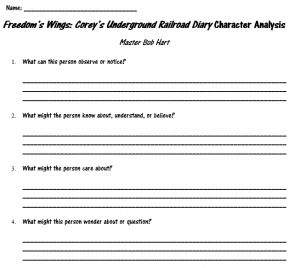
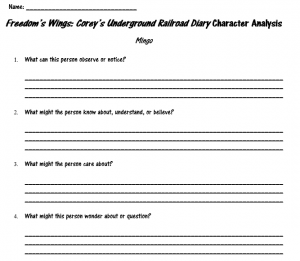
- The students would then share their responses with their groups and have a discussion about their responses. I would have the quote, “What makes you say that?” posted at each group to guide the students in their discussion.
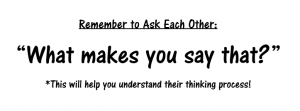
- We would come together as a whole class and the students would then share their responses and I would record their responses on a large sheet of paper to display in my classroom as we finish the unit.
Assessment
- My assessment would be based on what the students wrote down on their forms. I would also be actively conferencing with each group to make sure they were having meaningful discussions. I would record their interactions on a document similar to the one that can be found at https://www.pinterest.com/pin/272116002464540858/ so that I would be able to monitor their thinking process and be able to interject when necessary.
Materials
- Freedom’s Wings: Corey’s Underground Railroad Diary by Sharon Dennis Wyeth.
- Forms to record student responses
- Large paper to record all student responses
Next Steps:
- The following day I would have students write a journal entry that could be included in the diary written from another character’s perspective of their choice. I would also use the record of what I wrote while conferencing with each group to guide them in their writing.
Lesson Plan #2
Standards:
- RI.4.1 Refer to details and examples in a text when explaining what the text says explicitly and when drawing inferences from the text.
- RI.4.2 Analyze informational text development.
- a. Determine the main idea of a text and explain how it is supported by key details.
- b. Provide a summary of the text that includes the main idea and key details, as well as other important information.
- RI.4.4 Determine the meaning of general academic and domain-specific words or phrases in a text relevant to a grade 4 topic or subject area.
- SL.4.1 Engage effectively in a range of collaborative discussions (one-on-one, in groups, and teacher-led) with diverse partners on grade 4 topics and texts, building on others’ ideas and expressing their own clearly.
- c. Pose and respond to specific questions to clarify or follow up on information, and make comments that contribute to the discussion and link to the remarks of others.
- d. Review the key ideas expressed and explain their own ideas and understanding in light of the discussion.
Objectives:
- I can refer to details and examples in the article when explaining my own thinking.
- I can analyze the article and provide the main idea of the article. I can then provide a summary of that article using details from the text.
- I can effectively engage in a collaborative discussion with my peers expressing my own opinions and responding to others’ ideas.
Lesson:
- I would divide the students into different groups with each group assigned to a different civil rights article with topics such as Martin Luther King Jr., Rosa Parks, Little Rock Nine, Brown vs. Board of Education, etc. which I found at https://www.teacherspayteachers.com/Product/Close-Reading-Task-Cards-The-Civil-Rights-Movement-2403016.
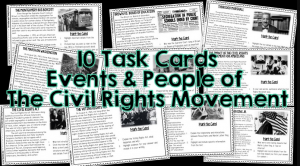
- I would have the students each read the article they were given and have them discuss with their groups what their thoughts were while reading the article. I would then have the students write down on a graphic organizer what sentence, phrase, and word they chose independently which I found on the website: http://www.rcsthinkfromthemiddle.com/sentence-phrase-word.html. Once completed, they would have the opportunity to share with their groups.
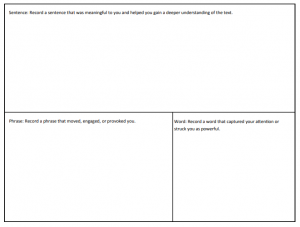 (If this lesson is not the first time the students did an activity like this, I would use the graphic organizer below, which can be found on the same website as above.)
(If this lesson is not the first time the students did an activity like this, I would use the graphic organizer below, which can be found on the same website as above.)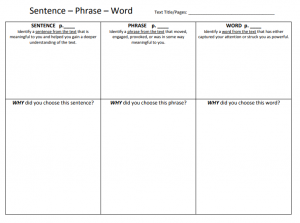
- The groups would then share their findings to the class and I would record their responses to display in my classroom. Afterwards, the whole class could have a discussion as to what the common themes were between the articles which we would also record.
Assessment:
- My assessment would be based on what the students wrote down on their graphic organizer. I would also be actively conferencing with each group to make sure that they were having meaningful discussions. I would record their interactions so that I would be able to monitor their thinking process and be able to interject when necessary.
Materials:
- Civil Rights Articles found on www.teacherspayteachers.com
- Graphic organizer to record student responses
- Large Paper to record all student responses
Next Steps:
- The following day I would show the students a YouTube video such as the one below. https://www.youtube.com/watch?v=URxwe6LPvkM
- I would then have students write a summary of what they learned using the word, phrase, and sentence that they chose the previous day. This would include knowledge of the article that they had to read and what they learned from other groups’ presentations.
